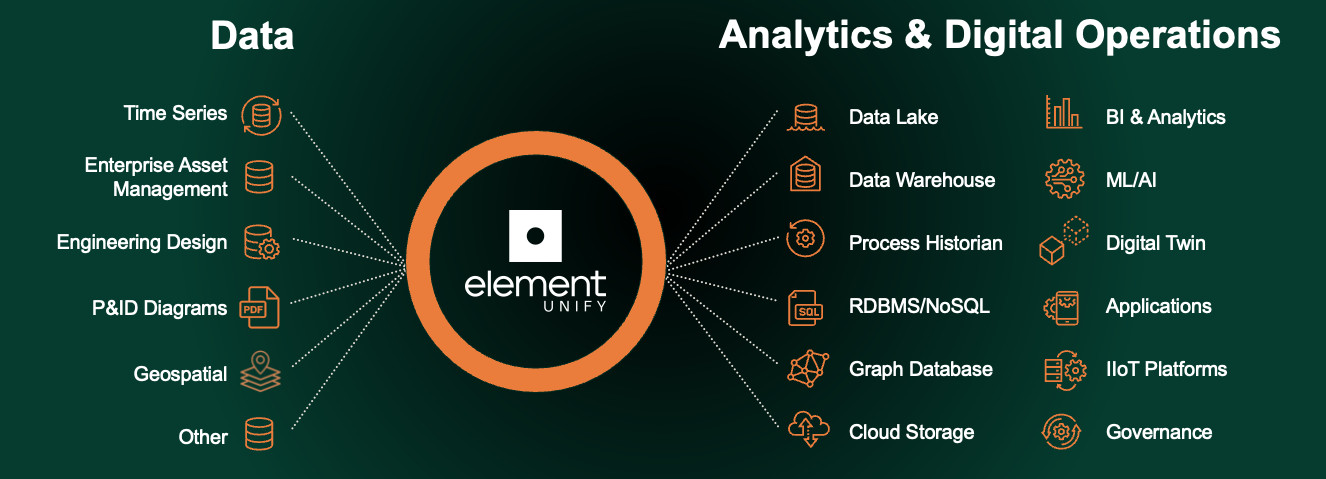Amazon, Netflix, and Google are companies most of us use every day. We get value from them that keeps us coming back for more. How do these companies manage to do this? They use data as a strategic asset. They track searches, clicks, views, and so much more to cater to users’ individual preferences so they can serve up what their algorithms determine you might also be interested in. The same data is used differently to forecast future offerings and programming on a global scale. It all comes down to viewing data as a strategic asset. It provides them a competitive advantage in their respective marketplaces.
What does it mean for traditional industries to use data as a strategic asset?
Data is now at the center of industrial operations. Every plant in operation is creating data – lots and lots of data. And companies have to view their data strategically in order to navigate the Industrial Transformation (IX) successfully. Of course, the audience, information, and goals are very different from the consumer focus of the companies mentioned above, but the overarching tenets are the same.
The IX Journey

Currently however, across industrial operations, we’re seeing that industrial data consumers – from plant managers to data scientists to executives – are struggling to manage all this data, make sense of it, and to use it to impact business outcomes. This is costing companies millions of dollars in waste and missed opportunity.
Developing a DaaP Mindset
A strategic approach to OT data is like developing the scaffolding for your organization to push change, shifting the mindset from project to product focused. We call this strategic way of thinking The DaaP Mindset, or Data as a Product. For world-class operations, data is not just a means to an end. It is viewed as a strategic asset with enormous value to the organization and its managed accordingly.
Accenture’s report “Building data products as a competitive differentiator” summarizes some of the benefits of the DaaP mindset.
“Data products productize data to accelerate value, improve decision-making, and even create entirely new revenue streams… Data products typically offer far greater ROI and lower cost-per-use than data projects, because they evolve to support multiple outcomes over time.”
Working From One Source of Truth – the Internal Data Marketplace
Taking a strategic approach to data, we can create an internal marketplace or repository through which anyone, anywhere in the company can leverage shared internal data. By developing practices around data collection and management with a common source of truth, we can derive value by optimizing processes and projects across the organization.
We don't have to recreate the wheel each time, for each project, which can take months or years. We’re moving beyond simply collecting files, scripts, and tables. The value of data outlives the project and can be reused again, again.
Optimizing Global Operations
Imagine a world in which we are able to bring all this operational data together, contextualize it, and connect it to your enterprise data. With the data marketplace, you can access the data you need when you need it without having to go to the IT department for tech support or Ops teams to try to get the information you need. Element Unify helps organizations build and govern data products so this can now become a reality.

For example, with Unify, a Major Oil and Gas Company was able to align 100 billion data points across 33 of its offshore platforms. This resulted in approximately $16 million in cost savings and a 90% reduction in the efforts required to build Asset Frameworks (AF).
Their VP of Maintenance and Reliability explains:
“Element’s value is delivering trusted data from source to consumer so that we can reduce the amount of unplanned outages and deferrals, and maximize margin. They are helping us harmonize our data, and ensure its reliability, so we can use it with all of our applications in a trustworthy, repeatable fashion.” You can read the full case study if you’d like to learn more.
Data scientists will no longer have to spend half their time on every project gathering and cleaning OT data. They can contextualize clean data and begin model building much more quickly. The Ops teams will no longer have to search for requested data that may be somewhere on a laptop or a thumb drive in the back of a desk drawer. For executives, they now have access to dashboards which show them how this all works together, provides prescriptive analytics, and can enable more sound decision making and planning. You don’t have to imagine anymore.
Want to Learn More?
Register to view a live demo of Unify or sign up for a free trial to use the software for 30 days. You can also sign up for a free trial or purchase a Personal License from the AWS Marketplace.
Questions? Please contact us.





